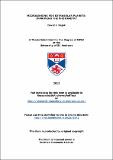Files in this item
Microlensing for extrasolar planets : improving the photometry
Item metadata
| dc.contributor.advisor | Horne, K. (Keith) | |
| dc.contributor.author | Bajek, David J. | |
| dc.coverage.spatial | 70 | en_US |
| dc.date.accessioned | 2013-03-01T17:01:28Z | |
| dc.date.available | 2013-03-01T17:01:28Z | |
| dc.date.issued | 2013-06 | |
| dc.identifier.uri | https://hdl.handle.net/10023/3372 | |
| dc.description.abstract | Gravitational Microlensing, as a technique for detecting Extrasolar Planets, is recognised for its potential in discovering small-mass planets similar to Earth, at a distance of a few Astronomical Units from their host stars. However, analysing the data from microlensing events (which statistically rarely reveal planets) is complex and requires continued and intensive use of various networks of telescopes working together in order to observe the phenomenon. As such the techniques are constantly being developed and refined; this project outlines some steps of the careful analysis required to model an event and ensure the best quality data is used in the fitting. A quantitative investigation into increasing the quality of the original photometric data available from any microlensing event demonstrates that 'lucky imaging' can lead to a marked improvement in the signal to noise ratio of images over standard imaging techniques, which could result in more accurate models and thus the calculation of more accurate planetary parameters. In addition, a simulation illustrating the effects of atmospheric turbulence on exposures was created, and expanded upon to give an approximation of the lucky imaging technique. This further demonstrated the advantages of lucky images which are shown to potentially approach the quality of those expected from diffraction limited photometry. The simulation may be further developed for potential future use as a 'theoretical lucky imager' in our research group, capable of producing and analysing synthetic exposures through customisable conditions. | en_US |
| dc.language.iso | en | en_US |
| dc.publisher | University of St Andrews | |
| dc.rights | Creative Commons Attribution-ShareAlike 3.0 Unported | |
| dc.rights.uri | http://creativecommons.org/licenses/by-sa/3.0/ | |
| dc.subject | Gravitatonial | en_US |
| dc.subject | Microlensing | en_US |
| dc.subject | Lucky | en_US |
| dc.subject | Imaging | en_US |
| dc.subject | Photometry | en_US |
| dc.subject | Extrasolar | en_US |
| dc.subject | Planets | en_US |
| dc.subject.lcc | QB857.5G7B2 | |
| dc.subject.lcsh | Microlensing (Astrophysics) | en_US |
| dc.subject.lcsh | Extrasolar planets | en_US |
| dc.subject.lcsh | Photometry, Astronomical | en_US |
| dc.title | Microlensing for extrasolar planets : improving the photometry | en_US |
| dc.type | Thesis | en_US |
| dc.type.qualificationlevel | Doctoral | en_US |
| dc.type.qualificationname | MPhil Master of Philosophy | en_US |
| dc.publisher.institution | The University of St Andrews | en_US |
This item appears in the following Collection(s)
Except where otherwise noted within the work, this item's licence for re-use is described as Creative Commons Attribution-ShareAlike 3.0 Unported
Items in the St Andrews Research Repository are protected by copyright, with all rights reserved, unless otherwise indicated.


